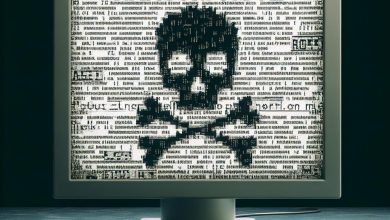
Table of Contents
US Government Disrupts BlackCat Ransomware Operation
In a significant move against cybercrime, the US government has taken decisive action to neutralize the threat posed by BlackCat, a sophisticated ransomware strain. This coordinated effort led to the release of a decryption tool that provided much-needed respite to victims of BlackCat attacks. The disruption came as a part of a broader operation undertaken by the Justice Department, which has directed considerable resources towards combating ransomware and other forms of cyber-extortion.
Announced Disruption and Decryption Tool Release
The US authorities announced the disruption of the BlackCat ransomware operation with much fervor, showcasing the country’s commitment to tackling cyber threats head-on. One of the notable outcomes of this operation was the release of a decryption tool. This was a major win for cybersecurity as the decryption tool provided victims with a means to regain access to their encrypted files without having to pay the ransom.
Justice Department’s Efforts Including Website Takedowns
The Justice Department played a crucial role in the offensive against the BlackCat ransomware group. Beyond developing and distributing the decryption tool, their actions included the strategic takedown of websites associated with the ransomware's operations. These takedowns disrupted the communication channels used by the attackers, impeding their ability to coordinate attacks, and disseminate malware.
Use of FBI Decryption Tool by Victims
The Federal Bureau of Investigation played a pivotal role in mitigating the damage inflicted by BlackCat ransomware by providing a powerful decryption tool to affected entities. This tool was engineered based on insight gained from the department's rigorous analysis of the ransomware and its mechanisms. Victims who had files encrypted by BlackCat were encouraged to use this tool to unlock their data, helping them recover from the attacks without succumbing to the cybercriminals' demands.
Savings from Ransom Demands Due to the Tool
The availability of the FBI-provided decryption tool meant that numerous victims could forego paying the ransoms demanded by the BlackCat perpetrators. These savings represented a significant financial win for individuals and organizations, as ransom payments can often escalate into millions of dollars. Furthermore, by not paying the ransom, victims avoid funding further criminal activities, thereby indirectly contributing to the overall effort to combat ransomware.
BlackCat Ransomware-as-a-Service: ALPHV or Noberus
BlackCat, also known as ALPHV or Noberus, has gained notoriety as one of the most advanced and insidious ransomware-as-a-service (RaaS) variants in the cybercrime ecosystem. Its sophisticated encryption algorithms and customized attacks make it a formidable threat to organizations across the globe, including those in critical infrastructure sectors.
Second Most Prolific Ransomware-as-a-Service Variant
The BlackCat ransomware has quickly become the second most prolific RaaS, demonstrating the efficacy of its modular design and the appeal of its commission-based operation to cybercriminals. Affiliates of BlackCat have carried out numerous attacks, each one tailored to exploit specific vulnerabilities in targeted systems, causing severe disruptions and financial implications for victims.
Law Enforcement Infiltration and Use of Informants
To combat the threat posed by BlackCat, law enforcement agencies have turned to infiltration and the use of informants. By gaining insights into the operational structure of the RaaS and the individuals involved, authorities have been able to identify weaknesses in the criminal enterprise, leading to substantial breakthroughs in their campaign against ransomware.
Seizure of BlackCat’s Operated Websites
In a move that has substantially impacted the effectiveness of the BlackCat ransomware group, authorities have seized control of several websites operated by them. These websites were instrumental in their RaaS model, used for negotiating with victims, processing payments, and distributing the ransomware. Their seizure has not only hindered BlackCat's operations but has also sent a strong message to other cybercriminal syndicates about the risks of such criminal endeavors.
Impact on Various Sectors Including Critical Infrastructure
The BlackCat ransomware has not discriminated in its targets, impacting a wide variety of sectors, with a concerning number of attacks directed towards critical infrastructure. The threat to critical infrastructure is especially alarming given the potential for widespread disruption and the implications for national security. The disruption of the BlackCat ransomware operation serves as a deterrent while providing a temporary reprieve for sectors that are constantly at risk of such debilitating cyberattacks.
The Modus Operandi of BlackCat Actors
Use of Affiliates to Exfiltrate Sensitive Data
BlackCat ransomware actors have implemented a devious affiliate program to execute their attacks, thereby outsourcing the criminal activity to a network of partners. These affiliates are responsible for infiltrating systems and exfiltrating sensitive data. Their role is critical in the RaaS (Ransomware-as-a-Service) business model, as they are the ones who oftentimes craft the tailored attacks, exploit vulnerabilities, and siphon off valuable information from victim organizations. In exchange for their services, they receive a percentage of the ransom payments, ensuring that both the core BlackCat team and their collaborators are financially motivated to continue and propagate their nefarious activities.
Ransom Demands in Exchange for Data Decryption and Non-Publication
Once sensitive data are in the hands of the BlackCat ransomware group, victims are faced with hefty ransom demands. To make an offer that's hard to refuse, BlackCat provides a "service" to the victims: payment of the ransom results not only in the promised decryption keys to recover their locked data but also in the assurance that the exfiltrated data will not be leaked or sold. This dual-threat approach vastly increases the pressure on victims to comply with demands, as they face both the loss of data and potential damage to their reputation and legal penalties associated with data breaches.
Pressure Tactics Targeting Sensitive System Data
To further compel payment, the BlackCat actors engage in aggressive pressure tactics that target especially sensitive or critical system data. By identifying and encrypting the most valuable data within an organization, they maximize the disruption to the business operations, forcing the hand of the victims to consider payment as the only feasible means to resume normalcy swiftly. This tactical maneuver exploits the urgency and desperation that accompanies the loss of critical data.
Use of Darkweb Leak Sites to Publicize Attacks
The BlackCat ransomware group employs an additional method to tighten the screws on their victims—the use of public leak sites hosted on the dark web. These leak sites serve as a platform not only to name and shame non-cooperating victims but also to auction or freely distribute stolen data. The threat of public disclosure creates a reputational incentive for victims to pay the ransom to preserve their public image and customer trust. These sites also provide negotiation channels for ransomware terms, making them an integral part of BlackCat's extortion strategy. Through these darkweb operations, BlackCat episodes become public spectacles that both promote their criminal successes and incite fear among future potential targets.
Government and Law Enforcement Response
Unsealing Search Warrants and Detailing BlackCat’s Actions
In a transparent effort to confront the menace of ransomware, the US government, through its law enforcement arm, has taken proactive steps to declassify details of its operations against BlackCat. By unsealing search warrants, the authorities have provided the public with comprehensive insights into the modus operandi of this cybercriminal group. This act of openness not only educates the public on the sophistication of BlackCat's operations but also showcases the depth and coordination of government efforts to trace and destabilize such nefarious activities. Through this transparency, law enforcement sends a clear signal about the serious implications of participating or collaborating in such illicit schemes.
Ongoing Prioritization of Cybercrime Ecosystem Disruption
The consistent attack campaigns of groups like BlackCat have led the government to prioritize the disruption of the entire cybercrime ecosystem. By employing multifaceted strategies that range from technical breakthroughs, such as the development of decryption tools, to intelligence-led operations, like the utilization of informants, the government aims to dismantle the structured networks that enable cybercrime. Their objective is to don't merely address individual incidents but to undermine the economic models that make cybercrime a lucrative venture.
Role of Cyber Insurance in the Evolving Threat Landscape
The rising tide of ransomware attacks has brought the role of cyber insurance into sharp focus. Insurance companies find themselves at a crossroads, needing to adapt their policies to the evolving threat landscape without incentivizing the payment of ransoms. Governments and law enforcement remain engaged with insurance industry players to balance the need for coverage with the unintended consequences that insurance proceeds may have on encouraging ransomware activities. To this end, policy adjustments and collaborations with cybersecurity agencies are becoming increasingly integral to developing sustainable cyber insurance models in the face of a burgeoning threat.
Industry Experts’ Perspectives on Ransomware Trends and Cybersecurity
As ransomware becomes a mainstay in the cybersecurity threat landscape, industry experts are offering crucial perspectives on upcoming trends and defensive paradigms. They contend that ransomware will continue to evolve, with actors leveraging more sophisticated techniques, and targeted sectors likely to expand. The sentiment among experts is that a multi-layered approach to cybersecurity is paramount, integrating robust proactive measures, thorough employee training, and the fostering of a collaborative culture of security. Continuous investment in cybersecurity infrastructure and the sharing of threat intelligence are seen as vital steps in creating resilient systems. Additionally, experts underscore the importance of partnerships between the private sector and government agencies in sharing resources, capabilities, and knowledge to create a unified front against the growing sophistication of ransomware operatives.




